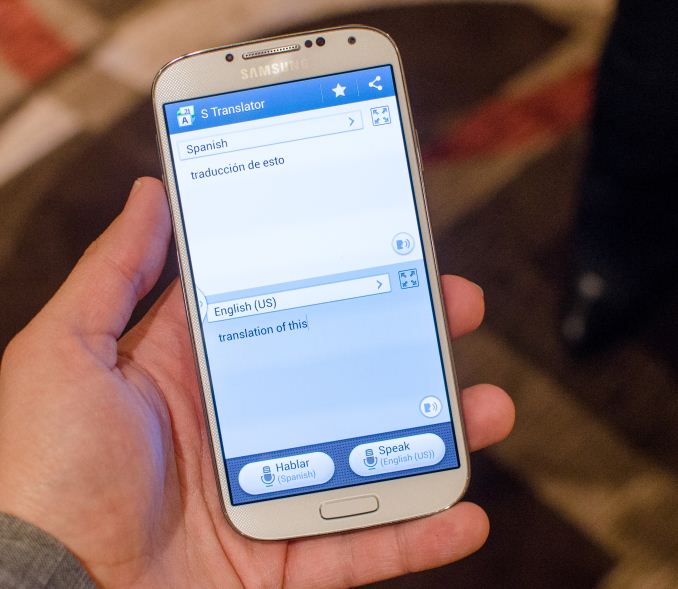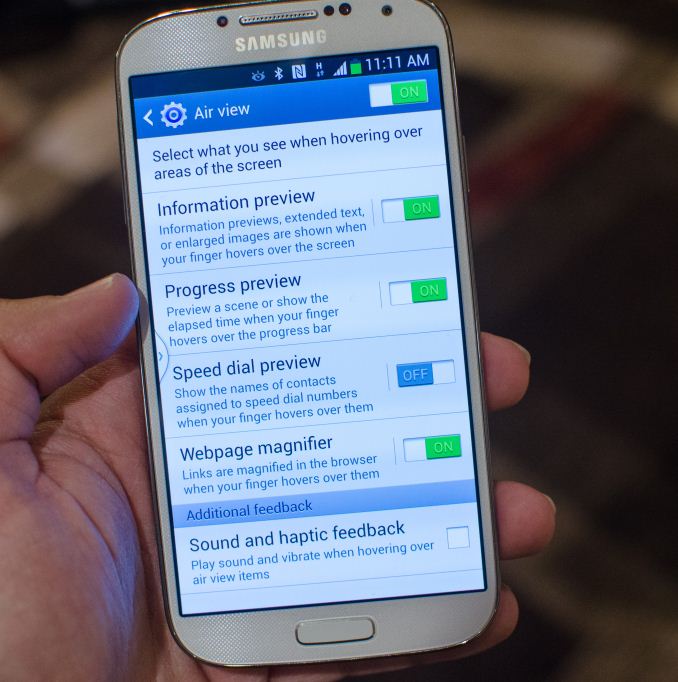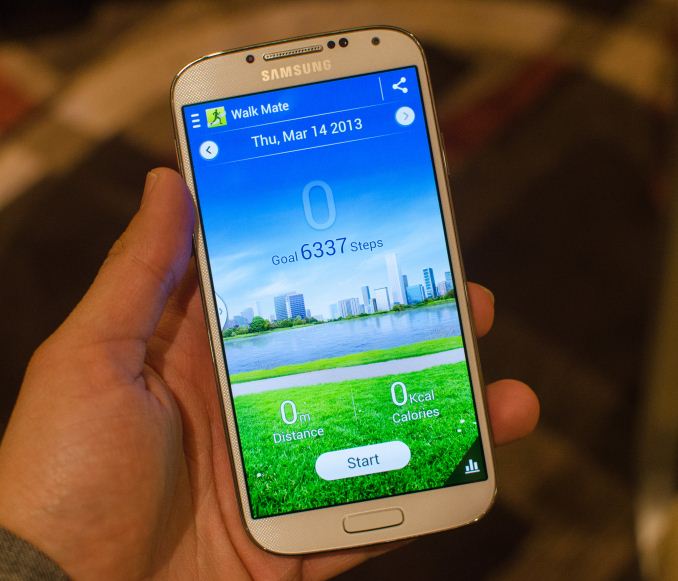Samsung's Galaxy S 4: Introduction & Hands On
by Anand Lal Shimpi on March 14, 2013 7:30 PM EST- Posted in
- Smartphones
- Samsung
- Mobile
- Galaxy S 4
S Translator
Samsung is shipping its own cloud based translation app on the Galaxy S 4 called S Translator. Chinese, English (US/UK), French, German, Italian, Japanese, Korean, Portuguese and Spanish languages are all supported at launch.
You can type or speak sentences to be translated and either read the translation or have your phone speak it. This functionality has been enabled by Google Translate for a while now, but turning it into a feature and making it very obvious on the Galaxy S 4 is a clear attempt to hit a broader audience.
Based on my limited experience with the translation, it seems like the bulk of the work is being done in the cloud. Samsung isn’t announcing what partner it’s using to do the actual translation at this point.
S Translator is also supported in the Email and ChatON apps.
Group Play
The Galaxy S 4 supports wireless streaming of music to up to 8 other SGS4 devices with a feature called Group Play. What Group Play does is allows you to wirelessly tether multiple SGS4s together to all play the exact same song. The idea is to leverage multiple devices to fill a room up with audio.
It’s not clear what application/DRM limitations exist here, but I can see this being the new tap-to-share for encouraging groups of friends to all buy Galaxy S 4s.
Air View & Air Gesture
With the Galaxy Note series of devices, Samsung enabled hover support with the S Pen. Holding the S Pen above the screen would enable you to preview video, peek at the contents of an email, etc... With the Galaxy S 4, Samsung enables the same functionality - but without the S Pen. It’s called Air View.
Through some clever tuning of the capacitive touch stack, the Galaxy S 4 is able to sense the presence of your finger up to about a centimeter away from the display. Air View works in Samsung’s web browser as a magnifying lens or to trigger a preview of open tabs. It also works in the email and gallery apps as well. Update: You can also use the SGS4 with gloves on, similar to Nokia's Lumia 920.
The Galaxy S 4 also supports Air Gesture, which leverages the IR gesture sensor to enable large hand gestures for UI control. You can swipe your hand in front of the smartphone to switch songs, move between tabs in the web browser, or scroll up and down a web page. You can also use Air Gesture to answer a call, which Samsung views as a good solution for SGS4 owners that have their smartphone in a car dock while driving.
Smart Pause & Smart Scroll
With the Galaxy S 3 Samsung introduced Smart Stay, another feature that leveraged the front facing camera to detect when you’re facing the smartphone and keep the screen on as a result. With the Galaxy S 4, Samsung expands the use of the front facing camera to enable pausing/unpausing of video playback depending on whether or not you’re looking at the display, and enabling tilt to scroll if the camera detects that you’re looking at it.
I tested both features and they seemed to work intermittently, although I’m not a fan of making judgement calls on software until final builds are available.
All of these gesture and camera based user interface features can be enabled/disabled, many on a per application basis but at minimum on a global level. Samsung does have a good amount of control/granularity in the SGS4 software for these features.
Samsung Optical Reader
The SGS4 will ship with some form of optical character recognition, allowing you to scan business cards and automatically populate your contact list with elements from the card. The Samsung Optical Reader app also supports reading QR codes.
S Health
The final new software feature of the Galaxy S 4 is called S Health. S Health includes support for an integrated pedometer, temperature and humidity sensors in the SGS4. The S Health app is supposed to be able to track distance traveled and give you local identification of current temperature and humidity. The app also includes the ability to act as a meal tracker, just look up foods you’ve eaten and it’ll keep a running tally of calories consumed. The S Health app and functionality is a clear attempt to integrate 3rd party pedometer hardware and apps into the phone itself - an obvious next step for any vertically integrated smartphone manufacturer.
Samsung will offer a line of Bluetooth health accessories that can interface with S Health, including a wrist band pedometer (S Band) so you can leave your SGS4 at home when you go for a walk/run, weight scale and heart rate monitor.
The S View Cover
Samsung will also have a new first party cover for the Galaxy S 4 called the S View Cover. This is a standard flip cover but with a small window cut out of the front of it. When the SGS4 detects that the cover is closed, it’ll display a small rectangle of information on its display (visible through the cutout in the cover). In this mode the display will give you the current time, battery/SMS/music status, caller ID and the ability to accept/reject calls. The S View Cover is a pretty neat offering from Samsung and one I see being very popular with anyone who used a flip cover with Samsung’s phones in the past.













206 Comments
View All Comments
tommydaniel - Thursday, March 14, 2013 - link
The S3 does have a stripe around it that is made to look somewhat metal-ish but is indeed plastic..CeriseCogburn - Saturday, March 16, 2013 - link
The iPhone4 is a lead weight - if belongs in an auto mechanics tool chest, not as a portable phone, and it's tiny screen is a health hazard.That's "quality" to our retard drooling monkeys, though.
Then they drop it, it shatters front or back or both, and they say " Damn! that really felt good, it's a high quality build !"
RETARDS.
RETARDED.
RETARDS
RETARDED
CeriseCogburn - Saturday, March 16, 2013 - link
You and all the appl wouldabee fanboys need to feel good when they rub their phone, it's their only companionship after all. The only hardware they will ever be holding in their hands.How it feels matters because they can't use it, they just drool on it while they stare at it's "feel", then they buy a cover anyway.
It's how retards function, which is too say, they are tamponic.
kpb321 - Thursday, March 14, 2013 - link
Interesting. If the A15 cores are only clocked at 1.2ghz max the Qualcom quad core will probably offer higher max performance. The Exynos 5 Octa may offer better battery life if it can spend most of its time using the A7 cores especially at lower clocks. I'd bet the US will get the Qualcom processor as that has been the trend lately.Aenean144 - Thursday, March 14, 2013 - link
Yeah. A 1.2 GHz Cortex-A15 doesn't sound all that competitive to a 1.5 GHz Krait or Swift, and it appears 2013 Kraits will be in the 1.6 to 1.9 GHz range. If 1.2 GHz is truly the max, either Samsung has put something extra in the Cortex-A15 to make competitive or they are going to be crushed by Kraits shipping at about 50% more clock frequency.sleepeeg3 - Thursday, March 14, 2013 - link
Clock frequency is a meaningless comparison between different architectures. I can't believe that's still being brought up on this site, of all places.Aenean144 - Friday, March 15, 2013 - link
It's not meaningless if you have a sense of the performance per cycle for the different architectures.Krait is about 3.3 DMIPS/MHz. A15 is about 3.5 DMIPS/MHz. Cortex-A9 is about 2.5 DMIPS/MHz. Cortex-A7 is about 1.9 DMIPS/MHz. Work it out from there. I got this info from this site.
lmcd - Friday, March 15, 2013 - link
3.3 was an exaggeration, 3.5 an underestimate. See the A15 versus S4 Pro with the Nexus 10 v 4.Krysto - Friday, March 15, 2013 - link
Did you see any of the benchmarks for A15 yet? It gets much higher scores than than 7% more that those "official" DMIPS would let you believe. Why do you think Samsung underlocked the A15's to 1.6 Ghz? They didn't want the international version to be much faster.Aenean144 - Friday, March 15, 2013 - link
Ok, are the A15 cores in the SG4 clocked at 1.6 GHz or 1.2 GHz? Anand is saying 1.2 GHz as of the original publishing of the article.Of course the DMIPS could be off by a bit, it's saying the Cortex-A15 is about 5 to 15% faster. Will it be off by 50% if the A15s are only clocked 1.2 GHz? Seems like a whole lot of performance to make up. I'm sure there are specific ops on an A15 that outperform a +50% clocked Krait, but on average? I'm kind of doubting it right. Wait and see.